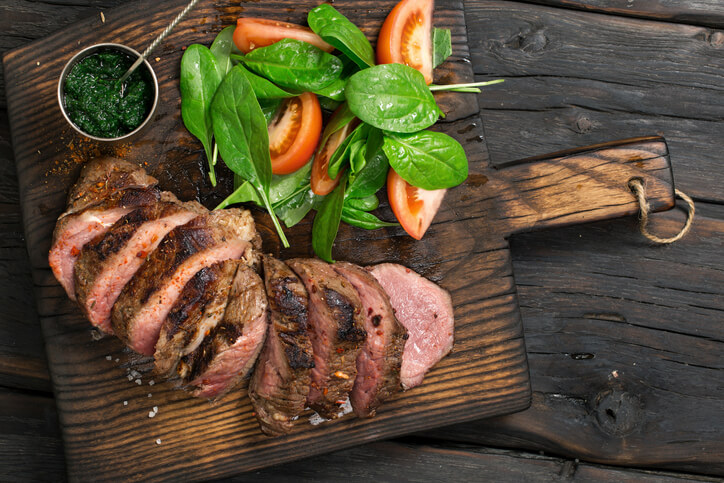
What Is an Ancestral Diet and How Does It Help You?

Page Contents:
In this article, I’ll go over the common characteristics our Paleolithic ancestors shared and I’ll explain how a Paleo or ancestral approach to what we eat can improve our overall health. Read on to learn what an ancestral diet looks like and get five health benefits to eating more like a hunter–gatherer.
What is an ancestral diet? Check out this article to find out some common characteristics our Paleolithic ancestors shared and learn five health benefits of eating Paleo. #chriskresser #paleo #optimalhealth
Chronic Disease Plagues the Modern World—and Diet May Be to Blame
Chronic disease has reached epidemic levels in developed countries. Incidences of type 2 diabetes, obesity, autoimmune disease, mental health disorders, and more are skyrocketing. Six in 10 American adults have a chronic disease, while four in 10 suffer from two or more chronic conditions. (1)
According to the best archaeological evidence, our ancestors didn’t develop these inflammatory, chronic diseases. And neither do modern-day hunter–gatherers. Consider the following examples:
- The Tsimané people in Bolivia have an 80 percent lower rate of atherosclerosis than people in the United States. (2)
- In Tanzania, less than 2 percent of Hadza adults are overweight (compared to nearly two-thirds of American adults), and diabetes is virtually non-existent. (3)
- The Maasai in Kenya do not develop cardiovascular disease, despite a diet based on red meat, blood, and milk (4) (so much for the theory that saturated fat and cholesterol cause heart disease …). (5)
What changed between then and now? When we don’t live or eat as our ancestors did, a mismatch between our genes and the environment fuels the fire for chronic disease. Ancestral health—and an ancestral diet—is the solution for that mismatch.
With the Industrial Revolution and technological advancements, quality of life has improved in many ways, but our health continues to decline. Although food is just one factor that impacts health (movement, sleep, and stress are a few others), we can’t escape the truth of the phrase, “you are what you eat.” The standard American diet, veganism, and even vegetarianism are far cries from what our ancestors ate, and far from what our genes and biology demand. Instead, you’re built to thrive on an ancestral diet.
An ancestral approach to diet and lifestyle has the power to prevent or reverse chronic disease. And, when that approach is coupled with the support of a trained Functional health coach, it can change lives. In the ADAPT Health Coach Training Program, we’re educating the next generation of Functional health coaches. If you want to make a living by making a difference, this could be the right career for you. Find out more.
What Is an Ancestral Diet?
The makeup of our ancestors’ diets varied widely, depending on geographical location, food availability, and technology. Even macronutrient ratios (percent of carbs, protein, and fat) significantly differed among hunter–gatherer populations. But some key features unite virtually all diets of our Paleolithic ancestors and modern-day hunter–gatherers.
Animal Products
Our hominid ancestors have been eating animal products for at least 2.5 million years. (6) Animal foods are among the most nutrient-dense foods on the planet. Some of the nutrients they contain in high amounts are difficult to get elsewhere, as the plant versions are poorly absorbed and/or converted. Some of these nutrients include:
- Vitamin B12 (liver, seafood, red meat)
- Choline (pastured eggs, liver)
- Heme iron (red meat, liver)
- Docosahexaenoic acid (DHA) and eicosapentaenoic acid (EPA) omega-3 fatty acids (cold water, fatty fish)
- Vitamin K2 (grass-fed butter, pastured eggs)
- Selenium (fish)
- Preformed vitamin A (liver)
- High-quality protein (meat, eggs, dairy)
Importantly, animal products encompass more than just “meat.” Nose-to-tail eating better reflects a nourishing, ancestral diet. Bone broth and cartilaginous cuts are rich in the amino acid glycine, which helps balance out the high methionine content of meat. (7) Organ meats, like kidney and heart, are superfood rockstars. Liver may just be the most nutrient-dense food on the entire planet.
Not only are animal products nutrient-dense, but they contain more bioavailable forms of many nutrients, including protein, calcium, and iron compared to plant sources. (8, 9, 10)
Starchy and Non-Starchy Vegetables
For our ancestors, the ratio of calories from plant and animal foods varied quite a bit. In one field study of 229 hunter–gatherer groups, researchers found that animal foods provided over two-thirds of their calories on average, with a range of 26 to 99 percent. (11, 12) Only 14 percent of these societies obtained more than 50 percent of their calories from plant foods.
Contrary to the media’s portrayal of a “Paleo diet,” vegetables should take up the large majority of the volume of your plate, as they aren’t as calorie-dense as animal products. Even if you’re aiming for 50 to 70 percent of calories from animal foods, plant foods should comprise between two-thirds and three-quarters of the space on your plate. Plant foods feed your microbiome and aid digestion.
Vegetables are prime sources of many nutrients:
- Vitamin C
- Carotenoids
- Polyphenols
- Flavonoids
- Plant sterols and stanols
- Isothiocyanates and indoles
- Prebiotic fibers
- And more
Sometimes Grains and Legumes
Many are surprised to learn that grains and legumes may, in fact, be Paleo. Evidence for wheat, barley, and rice consumption date back thousands of years. (13) But these grains aren’t what you’d find in the grocery store aisles—rolled oats, flour, and white rice. Grains and legumes contain high levels of antinutrients that bind to nutrients and prevent their absorption in the gastrointestinal tract. (14)
Cultures who did eat these foods first soaked, sprouted, fermented, and/or leavened them to break down the natural nutrient inhibitors.
Sometimes Fruit, Nuts, and Seeds
When in season, modern-day hunter–gatherers eat wild berries, nuts, and seeds, if available geographically. Fructose from whole fruit, in moderation, is healthy and not harmful like added sugars in food and beverages. (15)
Maybe Dairy
OK, you got me—dairy definitely isn’t Paleo or ancestral in the traditional sense. Lactase persistence, or the ability to digest lactose from milk products into adulthood, didn’t emerge until around 10,000 years ago. (16) However, full-fat, pastured dairy is rich in many nutrients, including hard-to-obtain vitamin K2, and can be part of an ancestral diet if well-tolerated. This is an instance of where a more modern food can match with our genes.
Organic and Local
Our ancestors didn’t describe food with these terms—because all their food was “local” and “organic.” But with the advent of concentrated animal feeding operation farms, pesticides, and antibiotics, today we have to assume foods aren’t organic or local unless explicitly labeled as such.
Organic, sustainable farming and agricultural practices yield products that are higher in micronutrients, more economically and environmentally friendly, and lower in pesticides and other toxins. (17, 18) That’s what our ancestors ate.
No Refined Sugar, Flour, or Seed Oils
No ancestral diet or modern-day hunter–gatherer diet ever contained refined sugar, flour, or seed oils. Period. Together, these “Three Horsemen of the Apocalypse” promote overeating and inflammation, which is at the root of all modern disease. (19)
Unfortunately, vegetable oils and sugar together comprise 36 percent of the standard American diet. What’s more, these foods are practically devoid of nutrients. It’s no wonder that one-third of Americans are at risk for at least one vitamin deficiency or anemia. (20)
Tailoring Your Paleo Template
Humans are complicated creatures, comprised of billions of cells (and trillions of microorganisms!) that require approximately 40 different micronutrients for normal metabolic function. As the diets of our ancestors varied quite a bit, healthy primal diets today also vary to allow for individual needs and sensitivities.
This is why I use the term Paleo “template” rather than “diet.” Humans vary in genetic makeup, gene expression, health status, activity level, goals, and more. Individual dietary requirements will differ among a 20-year-old male athlete, an 80-year-old woman with light activity, and a 2-year-old toddler. You wouldn’t expect them to eat the same diet as each other.
Finding your optimal “diet” can require some tweaking. Your goals, activity level, age, and even genetic variations can influence dietary needs. If you suspect food intolerance, eliminate the suspects for 30 days, and then slowly reintroduce one at a time, to pinpoint the culprit. Some common triggers include FODMAPs, nightshades, dairy, and eggs. I go in depth into how to establish your own dietary template in my book, The Paleo Cure.
Five Benefits of an Ancestral Diet
Nutrition research is plagued with problems: healthy-user bias, unequal comparisons, conflicts of interest … the list goes on and on. However, clear benefits of a whole foods, ancestral diet are demonstrated in studies that compare hunter–gatherer diets and/or modern-day Paleo diets to modern diets like the standard American diet, vegetarian and vegan diets, and diets recommended by national health associations.
1. Longer Health Span
It’s a common myth that our Paleolithic ancestors lived only until age 30. (21) Lower life expectancies in these studies were heavily skewed by higher rates of infant mortality, no antibiotics, no emergency medicine, and more. In actuality, anthropologists report that, if modern hunter–gatherers survive childhood, their lifespans average around 68 to 78 years, quite similar to our own. (22) And without the development of chronic disease, those later years were probably of much higher quality than most elderly people experience today. An ancestral diet combined with the benefits of modern medicine will likely lead to a much longer health/life span than the U.S. average.
2. Weight Loss
Over two-thirds of U.S. adults are overweight. Calorie-for-calorie, ancestral diets are generally more satiating, leading to consuming fewer calories and contributing to weight loss. (23, 24) Although low-carb and ketogenic diets are all the rage, a study from Stanford showed that on average, people who reduce added sugar, refined grains, and processed foods lost weight over 12 months, regardless of the macronutrient ratios. (25)
3. Decreased Inflammation
Refined sugar, grains, and seed oils increase chronic inflammation and drive chronic disease. In contrast, ancestral diets that eliminate these foods and instead focus on nutrient-dense, whole foods, including both plant and animal products, have been shown to decrease markers of inflammation. (26, 27, 28) A 2019 meta-analysis of eight Paleo diet randomized controlled trials showed significant reductions in inflammatory marker C-reactive protein and also improvements in blood pressure, waist circumference, and lipid profiles. (29)
4. Reversal of Metabolic Syndrome
Metabolic syndrome affects one-third of American adults, and is characterized by having at least three of the following five markers: (30, 31)
- Large waist circumference
- High blood pressure
- Elevated fasting glucose
- Elevated triglycerides
- Low high-density lipoprotein (HDL) cholesterol
In clinical trials, ancestral diets outperform other diets recommended by national health organizations like the American Heart Association. A number of studies ranging in length from weeks to two years show that a Paleo diet improves blood pressure, body weight, waist circumference, triglycerides, HDL cholesterol, and low-density lipoprotein (LDL) cholesterol. (32, 33, 34, 35, 36)
5. Better Gut Health
Gut health, which encompasses gut wall integrity, microbiome diversity, and more, is linked to better overall health. (37) A 2019 study published in PLoS One found very diverse microbiomes in people who ate modern Paleo diets, and even compared them to traditional populations like the Inuit, Hadza, and Matses. (38)
Studies of ancestral populations who eat both animal and plant foods reveal greater microbial diversity compared to people following an industrialized diet. (39) Acellular carbohydrates, like refined flours and sugars, wreak havoc on the gut microbiome. (40)
An Ancestral Diet Lowers the Risk of Chronic Disease
Following an ancestral diet ensures a variety of nutrient-dense, whole foods, on which our biology and health thrive. The measurable health benefits of an ancestral diet, from decreased inflammation to improved microbiome diversity, lower the risk of chronic diseases, including: (37, 41)
- Cardiovascular disease
- Diabetes and obesity
- Neurological disorders
- Mood disorders
Together with other aspects of an ancestral lifestyle, following a primal, Paleo-type diet has the potential to help you live a life that is free from chronic disease.






